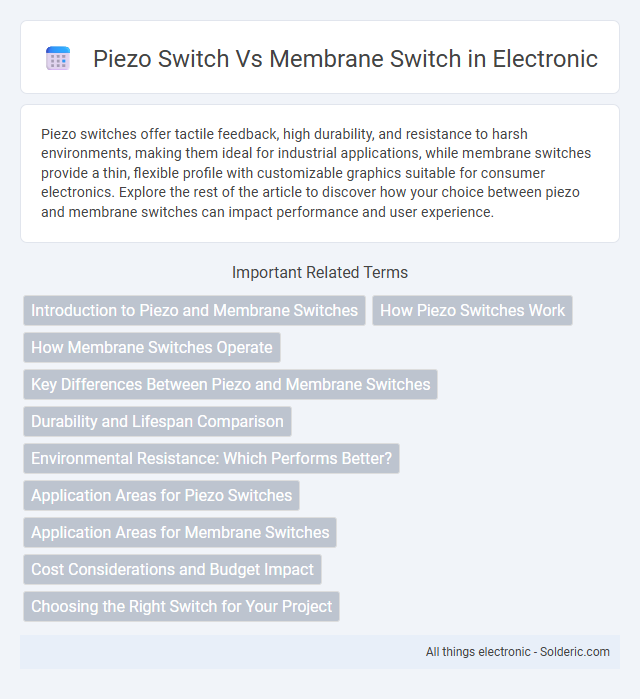Piezo switches offer tactile feedback, high durability, and resistance to harsh environments, making them ideal for industrial applications, while membrane switches provide a thin, flexible profile with customizable graphics suitable for consumer electronics. Explore the rest of the article to discover how your choice between piezo and membrane switches can impact performance and user experience.
Comparison Table
| Feature | Piezo Switch | Membrane Switch |
|---|---|---|
| Technology | Utilizes piezoelectric effect to detect pressure | Uses pressure-sensitive membrane layers with printed circuits |
| Durability | High durability, typically >1 million cycles | Moderate durability, usually 1-2 million cycles |
| Exposure Resistance | Highly resistant to moisture, dust, chemicals | Less resistant; vulnerable to moisture and contaminants |
| Operating Life | Up to 10 million actuations | Up to 1-2 million actuations |
| Sensitivity | Sensitive to very light touches | Requires more pressure to actuate |
| Cost | Higher manufacturing cost | Lower manufacturing cost |
| Applications | Medical devices, industrial controls, harsh environments | Consumer electronics, appliances, user interfaces |
| Thickness | Thin, compact design possible | Relatively thicker due to layers |
Introduction to Piezo and Membrane Switches
Piezo switches use piezoelectric materials to generate an electrical signal when pressure is applied, offering durability and a long lifespan due to the absence of moving parts. Membrane switches consist of multiple flexible layers with printed circuits, providing a thin, lightweight, and cost-effective interface commonly found in consumer electronics. Your choice between piezo and membrane switches depends on the required durability, tactile feedback, and environmental resistance for your application.
How Piezo Switches Work
Piezo switches operate based on the piezoelectric effect, where mechanical pressure applied to a piezoelectric material generates an electrical charge that triggers the switch. Unlike membrane switches, which rely on the physical contact of layers to complete a circuit, piezo switches have no moving parts, offering greater durability and resistance to environmental factors. This technology allows for fast response times and high reliability in harsh conditions such as industrial and medical applications.
How Membrane Switches Operate
Membrane switches operate through a layered construction where pressure applied to the top flexible layer completes an electrical circuit beneath it, enabling signal transmission. These switches use printed circuits on a flexible substrate, which activate when the separated conductive traces make contact via the pressure point. Your device benefits from their lightweight, sealed design, making them ideal for environments requiring moisture resistance and simple interface control.
Key Differences Between Piezo and Membrane Switches
Piezo switches operate using piezoelectric materials that generate an electric charge when pressed, enabling durability and resistance to environmental factors like moisture and dust. Membrane switches rely on layers of flexible substrates with printed circuits and require physical contact to complete the circuit, making them cost-effective but less robust against harsh conditions. Key differences include piezo switches' longer lifespan and tactile feedback versus membrane switches' affordability and customization options for low-impact applications.
Durability and Lifespan Comparison
Piezo switches offer exceptional durability with no mechanical moving parts, resulting in a lifespan of up to 100 million actuations, making them ideal for high-use applications. Membrane switches, composed of flexible printed circuits and overlays, typically provide around 1 to 5 million actuations before failure, which suits low to moderate use environments. Your choice between these switches should consider the required lifespan and the operational environment, where piezo switches excel in harsh conditions and extended durability.
Environmental Resistance: Which Performs Better?
Piezo switches outperform membrane switches in environmental resistance due to their sealed design, which protects against dust, moisture, and extreme temperatures, making them ideal for harsh industrial and outdoor applications. Unlike membrane switches, which rely on flexible layers prone to wear and damage from exposure, piezo switches offer greater durability and longer lifespan under challenging conditions. Your choice should consider that piezo technology ensures consistent performance and reliability in environments where contamination and physical stress are common concerns.
Application Areas for Piezo Switches
Piezo switches excel in harsh environments such as industrial control panels, medical devices, and outdoor kiosks due to their durability, water resistance, and ability to operate under extreme temperatures. Their non-mechanical operation reduces wear and tear, making them ideal for applications requiring high reliability and long lifespan. You can rely on piezo switches in settings where contamination or frequent cleaning is necessary, unlike membrane switches that are more suited for lighter-duty uses.
Application Areas for Membrane Switches
Membrane switches are widely used in medical devices, consumer electronics, and industrial control panels due to their durability and resistance to moisture and contaminants. They are ideal for environments requiring a sealed, easy-to-clean surface, such as in laboratory equipment and kitchen appliances. Your choice of a membrane switch ensures reliable, low-profile interface solutions in applications demanding consistent performance and user-friendly operation.
Cost Considerations and Budget Impact
Piezo switches typically involve higher upfront costs due to their durable, solid-state design and longer lifespan, which reduces replacement frequency and maintenance expenses over time. Membrane switches are generally more affordable initially, making them suitable for low-budget projects, but may incur higher long-term costs due to wear, reduced durability, and the need for more frequent replacements. When evaluating cost considerations and budget impact, piezo switches offer better value in high-use or industrial applications, while membrane switches remain economical for lighter, limited-use environments.
Choosing the Right Switch for Your Project
Choosing the right switch for your project depends on factors like durability, tactile feedback, and environmental resistance. Piezo switches offer high reliability and can withstand harsh conditions, making them ideal for industrial or outdoor applications. Membrane switches provide a cost-effective, low-profile solution best suited for consumer electronics and devices requiring a clean, sealed interface.
Piezo switch vs Membrane switch Infographic

 solderic.com
solderic.com